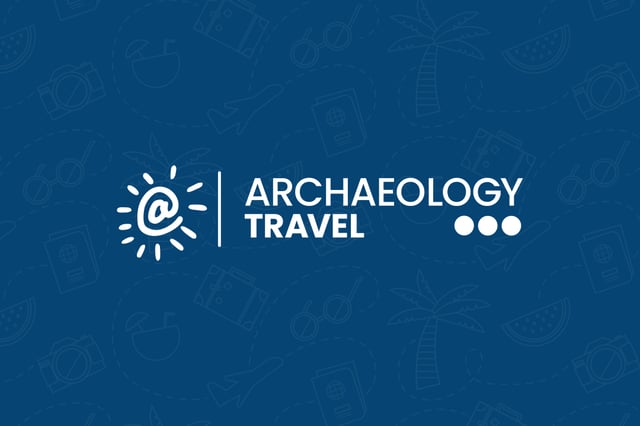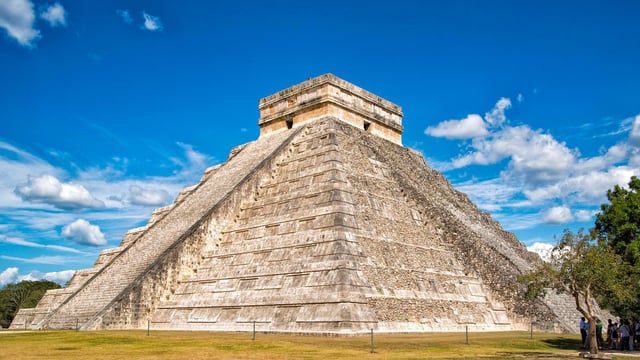Yucatán and the South
Art, History & Archaeology Sites & Museums
Archaeology & History Sites in Campeche
Balamkú
Only brought to the attention of archaeologists in 1990, the Maya ruins at Balamkú take their name from a Mayan language term meaning “Temple of the Jaguar.” This is a reference to the jaguars which appear on a stucco frieze created at the site between 550 and 600 AD, during the Classic period. Surrounded by jungle, the Balamkú archaeological zone is divided into three architectural groups; the South and Central areas have been partially excavated during the 1990s but the North area remains to be explored.

Dzibilnocac
Located in a forested area inside the town of Irtubide, the ruins at Dzibilnocac were brought to archaeological attention after being rediscovered by explorers in the mid-19th century. Taking its name from Mayan words for a “painted vault or vault with writing,” the settlement at Dzibilnocac arose in the Preclassic period but only reached its peak in the Classic period. Although parts of the ancient settlement are now beneath the modern town, since the 1980s various conservation and restoration projects have exposed more of this site for visitors to enjoy.

Edzná
Between 400 and 1000 AD, during Mesoamerica’s Classic Period, the site at Edzná was an important capital city in the western peninsula. Its name may derive from the term for ‘House of the Itzás’, the latter being a family name. A gradual decline in the city’s influence ended in its eventual abandonment around the year 1450, although the exact reasons for this remain a mystery. Due to the lengthy time in which it was an active settlement, the Edzná Archaeological Zone displays a range of architectural styles, including Chenes, Puuc and Tardíos.

El Hormiguero
With its name deriving from a Maya language term meaning ‘The Anthill’, the El Hormiguero Archaeological Zone preserves the remains of a Mayan settlement which reached its height between 600 and 800 AD, during the Late Classic period. Although known to archaeologists from at least the 1930s, excavation only began here comparatively recently, in the late 1970s. As such, there is still much of the site that is yet to be uncovered, concealed under soil and jungle foliage. Those parts which are visible include several impressive, highly decorated facades.

Hochob
Hochob derives its name from the term ‘ears of corn’, something first applied to the site in the 19th century. A settlement grew up here around 300 AD, at the start of the Classic Period, and reached its apogee between 850 and 1000. De-urbanisation followed, reflecting part of the broader ‘Maya collapse’ that archaeologists have identified in this region of Mesoamerica. A smaller community nevertheless continued to live here until after the Spanish invasion. Today, many buildings survive, including an ornate façade that reflects the Chenes architectural style.

Xpuhil
Named after a local plant that has a name meaning ‘cat’s tail’ in the Yucatec Maya language, Xpuhil is a settlement that was established by 400 AD. It probably reached its apogee between 600 and 800 AD, in the Late Classic Period. Although parts of the site have been destroyed through redevelopment, there are still five main groups of buildings present. Many of the surviving structures reflect the Río Bec architectural style, although Building 1 is atypical in having three towers rather than the two which are commonly found at Río Bec-style structures.

Archaeology & History Sites in Chiapas
Bonampak
Despite being smaller and less monumental than many other Mayan urban centres, Bonampak is known for its Temple of the Murals – indeed, it is this feature which gives the site its name, with “Bonampak” translating as “painted walls.” Offering a unique insight into Classic Mayan society, the extremely well preserved paintings depict daily life and the ritual activities of the royal court of Chan Muán, as well as scenes of the torture and sacrifice of people captured in war. The site also boasts a number of ornately engraved stelae.

Palenque
The ruins of Palenque stand as a testament to a Maya settlement that flourished in the Late Classic Period. While its original Maya name is not known, its present moniker derives from that of an adjacent Spanish settlement, Santo Domingo de Palenque. Surrounded by jungle, the ruins are generally well preserved and include the majestic Temple of the Inscriptions. The temples and palaces, with their many fine carvings and architectural features, have fascinated travellers since the 18th century. Since 1987, UNESCO have recognised Palenque as a World Heritage Site.

Yaxchilán
An example of a Maya urban settlement active in the Late Classic Period, Yaxchilán was at its height between 600 and 800 AD. At that time it was a major power in the region, its rulers apparently dominating the Usumacinta River area. One of the reasons it is such a significant site for Mesoamerican archaeology is the large collection of texts that have been found here, inscribed onto stelae, altars, and lintels. Many of these described wars or the establishment of alliances, giving further insight into ancient Mesoamerican society.

Archaeology & History Sites in Quintana Roo
Cobá
The ruined Mayan city of Cobá can be visited in the jungles of southeastern Mexico, where several large temple pyramids and a series of ceremonial trackways remain visible – including the largest pyramid in Quintana Roo state. The settlement reached its apogee between 800 and 1000 AD, during the Late Classic and into the Early Postclassic Period, at which point it exerted influence over other communities in the region. Although local Maya communities never forgot about the crumbling city, it only came to the attention of archaeologists in the 1920s.

Mayan Museum of Cancun
Opened in 2012, the new museum houses one of the most important collections of the Mayan artefacts in Mexico. On display are objects from the state of Quintana Roo, but also significant artefacts from such Mayan sites as Palenque and Chichén Itzá, among others. Situated next to the archaeological site of San Miguelito, entry to the museum includes entry the site.

San Gervasio
Known by the Mayans as Tantun Cazumil, this site was a centre of pilgrimage for worshippers of Ixchel, a goddess associated with fertility, weaving, and the moon. Although lacking the monumentality of other Mayan sites, San Gervasio was an important ritual centre, with most of the surviving structures dating from the Late Postclassic Period. One of the surviving structures is named Las Manitas (‘Little Hands’) after the handprints found on the wall. San Gervasio is now part of a state park and is populated by a colony of iguanas.

Tulum
In the Yucatán Mayan language, the name ‘Tulum’ means ‘wall’ and probably refers to the partition enclosing this pre-Hispanic Maya settlement. Perched on a cliff-side, the ruins were part of a historic port and offer picturesque views overlooking the Caribbean Sea. The Spanish conquest of the area brought an end to continued occupation at Tulum, which was abandoned by the end of the 16th century. During the 20th century, archaeological investigation and conservation helped turn Tulum into one of Mexico’s most popular tourist attractions.

Archaeology & History Sites in Yucatán
Acanceh
Modern-day Acanceh is built on top of an ancient Mayan city that rose into a major regional centre in the Middle and Late Preclassic Periods, before further flourishing during much of the Classic Period. Decline followed during the Postclassic Period, with later residents building over the ruins or plundering them for building material. The site’s unusual name means “moan of the deer” in the Yucatec Mayan language. Although much remains to be excavated, the ancient city’s stepped pyramid and Palace of the Stuccoes have been conserved and are open to the public.

Chichén Itzá
Attracting over 2 million tourists each year, Chichén Itzá is one of the most visited archaeological sites in Mexico. Once a great centre of Maya civilisation that at its peak housed 35,000 people, it now survives as a series of monumental platforms, temples and a grand ballcourt. It was conquered by the Spanish in 1534 AD, but resistance from Mayan peoples prevented a Spanish settlement being established here. By the 19th century it was taken over by forest. Since 1988, Chichén Itzá has been recognised as a UNESCO World Heritage Site.


Mayapán
The ruins of Mayapán represent the remnants of one of the greatest Mayan cities, one that rose to regional dominance in the Postclassic Period – but which had been a place of settlement from at least the Preclassic Period. Over 4,000 structures are contained within the city walls, among them impressive temples, palaces and an observatory. In the Yucatec Mayan language, the site’s name means something akin to ‘the flag of the Maya’. The city was abandoned in the 15th century, and has been researched by archaeologists since the 1930s.

Uxmal
One of the great cities of the Mayan civilisation, Uxmal was the capital of a powerful city-state during Mesoamerica’s Late Classic era. The site is within walking distance of three hotels and a small museum, where visitors can see well-preserved palaces, temples and ceremonial track-ways, including the magnificent Pyramid of the Magician. Many of the structures have been executed in what is now called the Puuc architectural style, named after the low hill country in which they are found. Since 1996, UNESCO have recognised Uxmal as a World Heritage Site.















